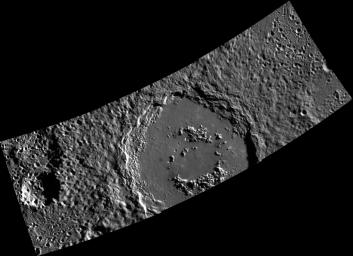
|
Alver is the Centerfold
- Click the image above for a larger view
- Full-Res JPEG (3022 x 2192) (505.6 kB)
- Full-Res TIFF (3022 x 2192) (6.6 MB)
Caption:
Alver is a large, peak-ring basin in Mercury's southern hemisphere. This mosaic, made up of three separate images, reveals a rough ejecta deposit, impact melt ponds , deposit, a smooth, cracked floor , terraced walls , and a peak ring . Give it a click and zoom in to see this basin in detail!
This image was acquired as a high-resolution targeted observation. Targeted observations are images of a small area on Mercury's surface at resolutions much higher than the 200-meter/pixel morphology base map. It is not possible to cover all of Mercury's surface at this high resolution, but typically several areas of high scientific interest are imaged in this mode each week.
Date acquired:
November 24, 2014
Image Mission Elapsed Time (MET):
59143618, 59143622, 59143626
Image ID:
7489056, 7489057, 7489058
Instrument:
Narrow Angle Camera (NAC) of the Mercury Dual Imaging System (MDIS)
Center Latitude:
-66.7°
Center Longitude:
77.2° E
Resolution:
131 meters/pixel
Scale:
Alver basin is approximately 151 km (94 mi.) in diameter.
Incidence Angle:
75.9°, 78.8°, 81.7°
Emission Angle:
6.1°, 2.0°, 2.7°
Phase Angle:
82.0°, 80.5°, 79.2°
Background Info:
The MESSENGER spacecraft is the first ever to orbit the planet Mercury, and the spacecraft's seven scientific instruments and radio science investigation are unraveling the history and evolution of the Solar System's innermost planet. During the first two years of orbital operations, MESSENGER acquired over 150,000 images and extensive other data sets. MESSENGER is capable of continuing orbital operations until early 2015.
For information regarding the use of images, see the MESSENGER image use policy .
Cataloging Keywords:
| Name | Value | Additional Values |
|---|---|---|
| Target | Mercury | |
| System | ||
| Target Type | Planet | |
| Mission | MESSENGER | |
| Instrument Host | MESSENGER | |
| Host Type | Orbiter | |
| Instrument | Mercury Dual Imaging System (MDIS) | |
| Detector | Narrow Angle Camera (NAC) | |
| Extra Keywords | Grayscale, Impact, Map, Radio | |
| Acquisition Date | ||
| Release Date | 2015-01-14 | |
| Date in Caption | 2014-11-24 | |
| Image Credit | NASA/Johns Hopkins University Applied Physics Laboratory/Carnegie Institution of Washington | |
| Source | photojournal.jpl.nasa.gov/catalog/PIA19017 | |
| Identifier | PIA19017 | |
